UCLan¶
Software-Development¶
CO2401¶
Make-Pretty¶
Contents Page
Lecture PowerPoint
Lab 2
Recap (Previous Lecture)¶
Requirements are formal descriptions of what software should do. They outline the functionalities, features, constraints, and characteristics that a software must have to meet the needs and expectations of users and stakeholders.
OO (Object-Oriented) Analysis and Design¶
Why draw diagrams?
Before building something, we often create drawings to describe its look and behaviour.
- Plans / Blueprints
UML is a language that was discussed in the first lecture.
The purpose of modelling a language is to represent the key features of a system.
Candidate Classes¶
Deciding the overall architecture of an OO (Object Oriented) system can be hard.
- What objects/classes should we create?
- How many objects should we create?
- Should we use inheritance/abstract classes
There are numerous ways to build a system, a way of deciding how objects/classes maybe needed is by looking at the User Stories and Use Case model.
Class, Responsibility and Collaborators - CRC Cards¶
A collaborative approach to determining the overall system architecture.
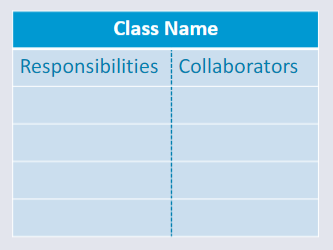
Empty CRC Card Example
Describe each class on a small card with the following details:
- Name of class
- List of responsibilities
- Things it knows
- Things it does
Collaborators (Deprived Classes)
- Other classes used by this class.
Purpose of CRC Cards¶
Used as a collaborative medium to brainstorm division of a programs components.
Allows the team to build a common mental model of how a program might work.
Allows quick visual test of alternative approaches/architecture before development begins.
Can be useful when changing/restructuring a program.
OO Design with CRC Cards¶
Identify User Stories/Use Cases (Scenarios)
Finding entities in the system
- Things in specification or domain or description
Filter out duplicate and insignificant entities
Assign responsibilities to classes
- The operations that a class supports
Identifying collaborations between classes
- Represent relationships between classes
Check that structure will support scenarios
Using CRC Cards¶
Use to develop and check design
- Walk through typical scenarios 'Use Cases'
Expect to modify
Use in group discussion:
- Anthropomorphise
- Pretend the class is 'alive' an active participate
- Keep related cards close together
- Allows for different perspectives to be heard
- Identify common patterns/outliers
CRC Cards Advantages¶
Suited to iterative development
Easy to add/remove and rearrange cards
Good for collaborative communication
Can be used very easily in development
- e.g. in foundations stage of DSDM
Finished OO (Object Oriented) analysis with CRC cards can provide architectural design guidelines.
Encourages development team to 'role play' through different usage scenarios.
New issues can be identified e.g. missing component
CRC Cards Disadvantages¶
Requires team participation
Both from business side and developers
Can become difficult to manage with very large systems
Too many cards to manage
Does not track sequence when running through scenarios
Lacks detail
Some organisations will require more formal representation of overall architecture
Example: CRC analysis¶
Perform a CRC analysis for a library:
Scenarios:
- User returns book
- User borrows a recording
- User searches catalogue for a journal
- Damaged item is removed from the catalogue
Expand use cases or user stories.
Identify candidate classes.
Create CRC Cards
Walk through scenarios.
User Stories (Library Example)¶
Tip: Look for nouns
As a user I want to be able to get a return receipt for my book so that I don't get mistakenly fined.
As a user I want to be able to borrow a recording so I can watch it at home.
As a student I want to be able to search the catalogue for a journal so I can get a good mark on my assignment.
As a librarian I want to remove a damaged item from the catalogue so that it can be repaired.
Identify some potential classes (Library Example)¶
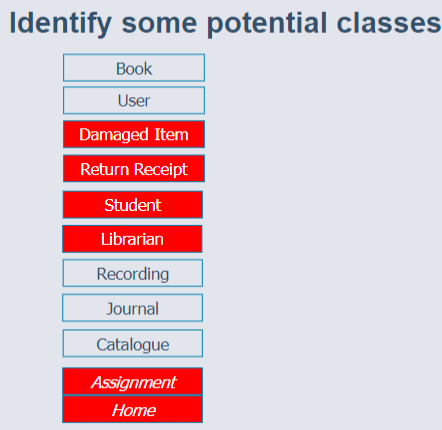
CRC Potential Library Classes
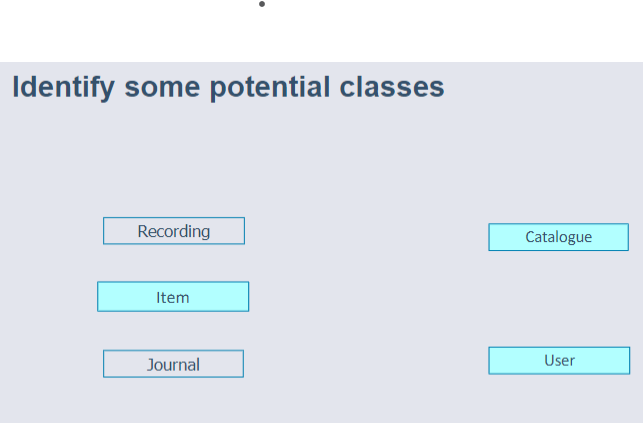
Library Example: Identifying classes
Create CRC Cards (Library Example)¶
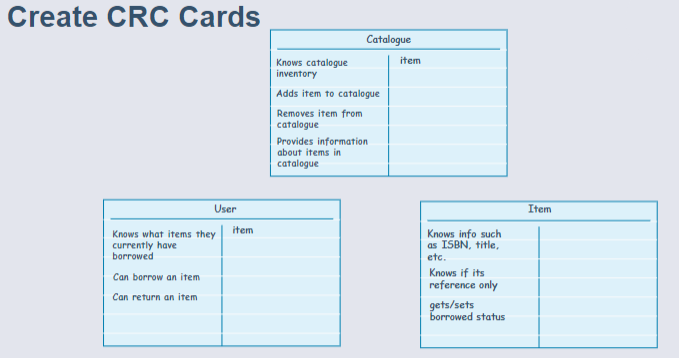
Library Example CRC Cards
Walk through scenario¶
User borrows a book (has a library card number and a book number to borrow)
How do we know they are a registered user?
With the current CRC cards we don't.

CRC Cards now with User List.
User borrows a book (has a library card number and a book number to borrow)
- we check UserList for details on that specific user (collaborates with user class to return user object for that user) if that user exists.
- User object checked for what items they already have (can they borrow more?) if eligible to borrow.
- We check catalogue for item to be borrowed? if item exists then return item object of the appropriate book.
- Item object checked for reference only: if not reference only
- Item object checked if it is out on loan: if available
- User object borrows item
- adds item to their borrowed items list
- sets items borrowed status to "borrowed"
Formalising CRC Cards¶
Swap responsibilities for properties/methods
Properties (things for class knows) can also be written on the back of the card.
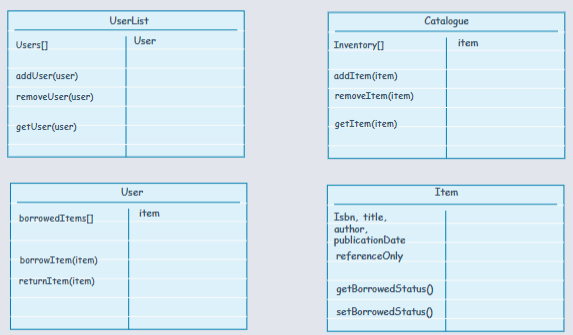
Formalising CRC Cards
Why Use CRC Cards¶
Simplicity.
At a high level they can be used with clients.
CRC cards encourage discussion as it promotes learning between team members.
Participants can experience how the system will work.
Check consistency of structure and use cases
Incremental
- in early design don't worry about details
- in detailed design can record properties on back
Class Diagram¶
Shows the different objects, their relationship, their behaviours, and attributes.
Provide visual representation of the structure and relationship of classes in a system.
Classes are the building block of objects
- Class diagrams are the building blocks of UML
Why Class Diagram?¶
To illustrate data models for information systems, no matter how simple or complex
To understand the general overview of the schematics of an application.
Visually express any specific needs of a system and that information to achieve business goals.
Components of Class Diagram¶

Annotated Class Diagram
Member Access Modifiers¶
Classes have different access levels depending on visibility.
| Access Level | Symbol |
|---|---|
| Public | (+) |
| Private | (-) |
| Protected | (#) |
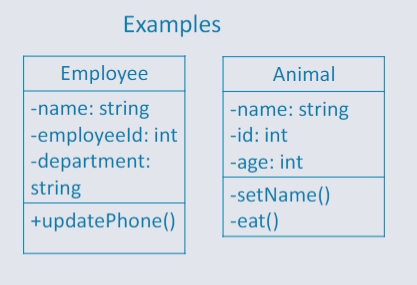
Class Diagram Example
Class Relationships¶
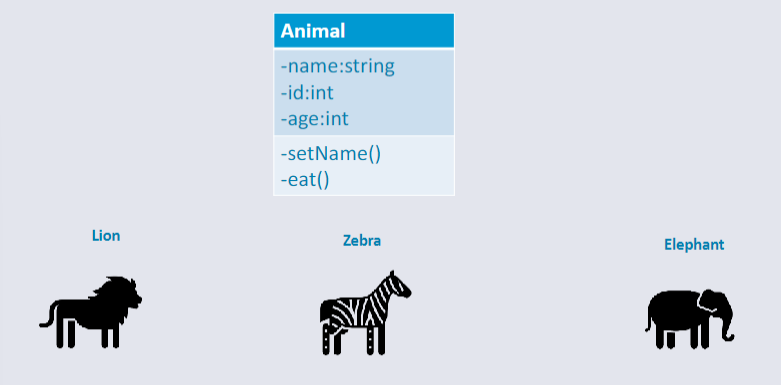
Class Relationship Diagram
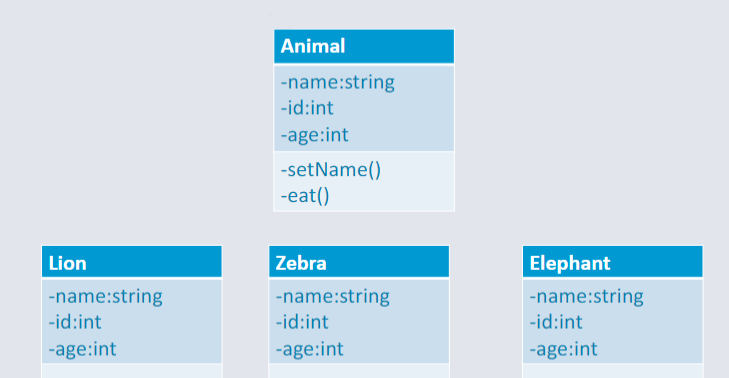
Class Diagrams for various animals
Inheritance¶
Class Diagrams with titles in italics or the class name may be wrapped in <<'class'>> (Single quotes not needed) are abstract classes.

Class Diagram Inheritance
Associations¶

Class Diagram Association
Aggregation¶
Aggregations are used to represent a "part of" relationship and indicate that one class (the whole) contains or is composed of one or more instances of another class (the part).

Class Diagram Aggregation
Composition¶
Composition indicate a strong "has a" relationship between two classes.

Class Diagram Composition
In the example above, the classes Lobby and Bathroom classes cannot exist without the Hotel class.
Multiplicity¶
The multiplicity number is used to indicate the number of instances in a class:
"0..1": Zero or one instance
"1": One exact instance
"0..*": Zero or more instances
"1..*": One or more instances
"n": Exactly n instances

Class Diagram Multiplicity
Lecture Summary¶
UML provides notation for modelling system
An object is some entity relevant to a system
- it has behaviour - methods
- It has state - properties / attributes
A class is a blueprint for objects
- Defines the properties and methods of objects
Class Diagram shows types of entity and their relationships
CRC cards allow developers to role-play objects in a system walkthrough.